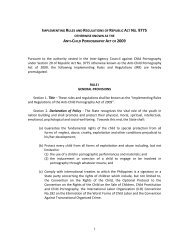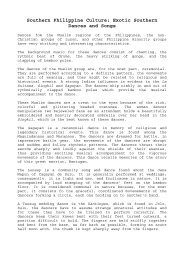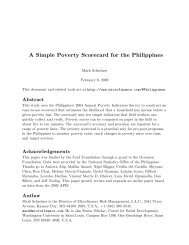Bangus or Milkfish Cultivation Systems in the Philippines
Bangus or Milkfish Cultivation Systems in the Philippines
Bangus or Milkfish Cultivation Systems in the Philippines
Create successful ePaper yourself
Turn your PDF publications into a flip-book with our unique Google optimized e-Paper software.
Intensive cultivation of bangus <strong>in</strong> <strong>the</strong> Philipp<strong>in</strong>es.<br />
In Sarangani Prov<strong>in</strong>ce, where <strong>the</strong> FHI’s hatchery is located, bangus production has <strong>in</strong>creased<br />
considerably. Actually, <strong>the</strong> hatchery is <strong>in</strong> Lun Masla, Malapatan. Here, about 13,000 breeders are<br />
ma<strong>in</strong>ta<strong>in</strong>ed and managed to produce bangus eggs on a daily basis throughout <strong>the</strong> year. The eggs are<br />
collected, cleaned and hatched. The hatchl<strong>in</strong>gs are grown to <strong>the</strong> marketable sizes <strong>in</strong> 18-21 days <strong>in</strong> larval<br />
ponds. Dur<strong>in</strong>g <strong>the</strong> grow<strong>in</strong>g period, <strong>the</strong>y are fed with a mixture of planktons and commercial feeds.<br />
The breeders are 50% males and 50% females. “It is tedious to sex <strong>the</strong> fish <strong>in</strong>dividually and tag <strong>the</strong>m,”<br />
Bocaya expla<strong>in</strong>s. “We have some breeders that are m<strong>or</strong>e than 25 years old and are still breed<strong>in</strong>g <strong>in</strong><br />
groups well.”<br />
It takes 5 years f<strong>or</strong> a bangus to mature sexually. FHI selects breeders f<strong>or</strong> commercial production only<br />
when <strong>the</strong>y are 8 years old. The female mature breeder, called sabalo, can produce seven kilos of eggs <strong>in</strong><br />
one year. And one kilo consists of 750,000 eggs.<br />
<strong>Bangus</strong> spawns <strong>in</strong> ponds <strong>in</strong> frenzy at night. The sabalo release <strong>the</strong> eggs while <strong>the</strong> males discharge <strong>the</strong><br />
milt. Fertilization happens externally <strong>in</strong> <strong>the</strong> pond water. There is no need f<strong>or</strong> h<strong>or</strong>mone <strong>in</strong>duction f<strong>or</strong><br />
mature breeders. The eggs are collected <strong>in</strong> nets <strong>in</strong> <strong>the</strong> early m<strong>or</strong>n<strong>in</strong>g. They are cleaned and placed <strong>in</strong> <strong>the</strong><br />
larval ponds immediately.

















